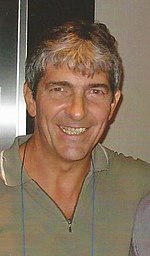Paolo Rossi
With success at club and international level, he is one of nine players to have won the FIFA World Cup, the UEFA Champions League and the Ballon d'Or.
[8][9] Although he was a member of the squad during the 1972–73 season, Rossi made his debut in professional Italian football with Juventus in 1973, making an appearance in the Coppa Italia and winning a runners-up medal in the 1973 Intercontinental Cup.
Coach Giovan Battista Fabbri decided to move him from the wing and place him in the centre of the attack (because of injuries to the then centre-forward) just before the season started.
Rossi immediately showed a tremendous knack for getting open in the box and scoring, winning the Serie B Golden Boot with 21 goals in his first year in this more advanced position.
Due to his performances, he was selected by the Italian national team's manager Enzo Bearzot for the 1978 FIFA World Cup.
This simple stratagem, made possible by the technical quality of all three players, created havoc for opposing defences, and Italy showed an entertaining offensive style of play in the tournament.
He was named as part of the team of the tournament for his performances, and he also collected the Silver Ball as the second-best player of the World Cup.
When the two clubs were called to settle the property, Lanerossi offered the shocking sum of 2.612 billion lire for Rossi, who became the world's most expensive player, and Italy's most costly sportsman ever at that point.
During the season, however, he was involved in the infamous 1980 betting scandal known in Italy as Totonero, and as a result of this Rossi was disqualified for three years, although this was later reduced to a two-year ban.
[14][15] Despite his ban, Rossi was repurchased by Juventus in 1981, and he returned to the starting line-up just in time for the end of the 1981–82 season to contribute to the club's 1981–82 Serie A title (scoring one goal in three appearances), and to take part in the 1982 FIFA World Cup in Spain.
[10] Italian journalists and tifosi initially lamented that he was in very poor shape, however, and this view seemed to be confirmed by Italy's appalling performance in the three group matches, in which he was described as a "ghost aimlessly wandering over the field".
He also helped Juventus to reach the 1983 European Cup final, only to lose out to Hamburg; he finished the tournament as the top scorer, with six goals.
Rossi was also selected in Italy's squad for the 1986 FIFA World Cup in Mexico, but did not play in the competition; an injury caused him to struggle during the team's fitness tests, owing to the high altitude of the region.
[21] Rossi is Italy's joint all-time top goalscorer in the FIFA World Cup, with nine goals in 14 appearances over two editions of the tournament, alongside Roberto Baggio and Christian Vieri.
[22] In August 1990, he was named vice-president of Lega Pro Prima Divisione club A.S. Pescina Valle del Giovenco.
[10][12][14] Although Rossi was primarily known as a striker who mainly operated in the penalty area, he began his career as a right winger, and in his later career with Juventus, he was also deployed as a supporting forward or as centre-forward, but in a role known as a centravanti di manovra in Italian football jargon (similar to the modern false 9 role), owing to the offensive attributes of the club's new signings in midfield, in particular Zbigniew Boniek and Michel Platini, where his role frequently involved holding up the ball or dragging opponents out of position to create space for his teammates' runs with his excellent attacking movement off the ball.


